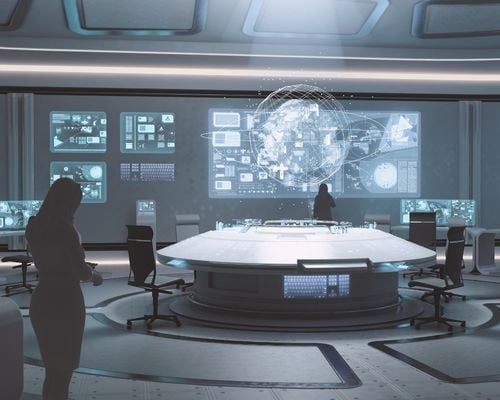n my last article, I spoke about the hesitancy standing in the way of multi-tier visibility. But once you have that visibility the journey has only just begun. The next immediate question becomes: what will you do with what is revealed to you? How will you act on what you see? From a solution perspective, you can think of the need as “actionable visibility” – often referred to as a Control Tower.
Then and Now: The notion of visibility and “control”
Years ago, when consumer electronics pioneer Bose Corp. in Framingham, MA had issues controlling and managing their supply chains, they came up with the concept of JIT-II – or Just-in-Time II. They ran tours to show it off; I recall being escorted in their HQ building, “The Mountain,” to a large office room with a near circular arrangement of workstations – much like an air traffic control tower (for which the eventual supply chain technology took its name). The stations were manned by procurement specialists who sat alongside their key vendors and whose key function was to expedite shipment movements to keep schedules on track and triage to meet commitments.
By today’s standards, it was pretty basic and analog. “Visibility” back then was paper-based, and “track and trace” (the “control” element) hinged on those representatives making phone calls. But they were the leaders and innovators of their time, and the initiative became a famous Harvard Business School case. Though much has changed since then, our goals remain the same: Businesses are still striving to keep the total cost down and satisfy their customers and meet their commitments. Except today, we have very different toolsets at our disposal. We have intelligent execution, circular supply chains, constraint identification and solutioning, impact prediction, algorithmic resiliency, machine learning, digital traceability et al. What was once a creative workaround to simulate technology we could only dream of, today that dream is fast becoming reality.
What is a cognitive control tower?
Control Tower technologies have and continue to evolve. Solutions vary widely in scope and depth, with systems traditionally only spanning transportation functions. But next generation platforms are taking a far more holistic approach.
In a recent newsletter from the Cognitive Automation Community, contributor Mir Kamin offers up an article defining the basic characteristics of Cognitive Control Towers. The technology doesn’t replace an existing management but sits on top of it for real-time data connectivity rather than batched. Cognitive Control Towers use this data alongside advanced analytics to identify exceptions and enable continuous process improvements.
This evolution didn’t happen overnight. We know that Multi-Enterprise Supply Chain Business Network technologies can sit on top of multiple IT systems and pluck information from each without needing a huge middleware project. Cloud technology has also provided bandwidth speeds and ubiquitous connectivity options, making real-time connectivity the norm. Most companies have standardized procedures, routings, etc., that make spotting exceptions easy. And, with machine learning (a form of artificial intelligence) its potential is greater than its limitations for calculating alternative solutions to those exceptions.
In essence, a cognitive control tower is the sum of these processes and advancements within a single, unified view and action station. The cognitive control tower is a digital hub that brings together people, processes, and technologies to create a 360-degree upstream and downstream view of an intelligent supply network, enable data-driven decision-making, identify challenges, and proactively respond to risks.
Why do you need it?
Bose was certainly advanced for their time, but given the sheer volume of information, network partners, and volatility in the global supply chain today, you can no longer optimize flows by sitting a small group of suppliers in a room and making some calls. When we say “cognitive control tower’ a video by Deloitte comes to mind that exemplifies its role quite well. Bose continues to innovate by leveraging one of the most advanced planning control tower technology on the market today.
The fact of the matter is organizations are simply dealing with too much data to process themselves in the span of seconds. The cognitive control tower offers algorithms that can process all requirements and constraints in miliseconds. As you can see from the video, to the customer the process is fast and seamless: input a request and be reassured with an OTIF delivery projection immediately. But what does it take to enable organizations to do that? To be reliably capable-to-promise?
It requires an immediate holistic view of all inventory – in transit, across your company’s sites, and across your customers’ sites, as well as your customers’ customers. It takes fast risk assessment, carrier and partner assessment, route and mode assessment, as well as service level requirements, capacity, the plans and movements of other flows for consolidation opportunities, and much more. What was a “cognitive possibility” back in the Bose example – a group of intelligent people in a room, is now the role of the cognitive control tower – of advanced intelligence and AI that helps teams see across their complex networks, process profound amounts of information across multiple systems and suggest the best options in an instant, and also help coordinate across those networks during execution through a single view and shared process capable of notifying teams and helping them to quickly adapt when exceptions occur.
There’s no doubt that in our complex and disruptive global marketplace, intelligent, optimized automation is pretty critical to maintaining operational excellence and high levels of customer service and satisfaction. So, how can you make it all happen? In my next post I’ll discuss tech ownership in the modern era, and why the right technology is not as cost-prohibitive as you might think.






